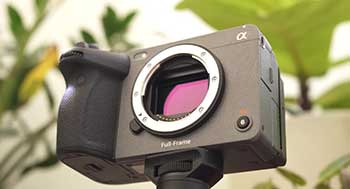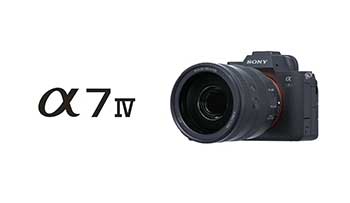Sony shook up the camera world by announcing two exciting new full-frame mirrorless cameras in 2021 – the FX3 cinema camera and the A7IV general purpose model. With both cameras sporting a similar 24MP sensor and form factor, it can be tough deciding which one is right for your needs.
In this in-depth comparison, we’ll analyze the key differences between the Sony FX3 and A7IV to help you pick the best option for shooting video.
A Brief Comparison Table
| Specs | Sony FX3 | Sony A7IV |
| Sensor Resolution | 12MP | 33MP |
| Sensor Size | Full Frame | Full Frame |
| Image Processor | Bionz XR | Bionz XR |
| ISO Range | 80-102,400 (exp. 409600) | 100-51,200 (exp. 204,800) |
| Max Video Resolution | 4K 120p | 4K 60p |
| Video Bitrate | Up to 280 Mbps | Up to 200 Mbps |
| Slow Motion | Full HD at 240fps | Full HD at 120fps |
| Stabilization | 5-axis IBIS | 5-axis IBIS |
| Autofocus Points | 627 PDAF + 425 CDAF | 759 PDAF + CDAF |
| Viewfinder | 3.68M-dot EVF | 3.69M-dot EVF |
| LCD Screen | 3.5″ vari-angle touchscreen | 3.0” vari-angle touchscreen |
| External Recording | HDMI and 3G-SDI | HDMI only |
| Battery Life | 440 shots (LCD) | 595 shots (LCD) |
| Dimensions | 4 x 5.3 x 3.5 in | 5 x 3.8 x 3 in |
| Weight | 1 lb 3 oz | 1 lb 2 oz |
| Price | $3800 (body only) | $2500 (body only) |
FX3 Overview
The FX3 boasts a feature-set optimized for serious videography, hence the “Cinema Line” branding. It takes many of the best parts from Sony’s cinema cameras like the FX6/FX9 and squeezes them into a smaller body.

Physically, the FX3 resembles an A7S III with some slight modifications. The most noticeable change is the all-black coloring and vented body designed for better cooling during long recording times. The 3.68 million dot OLED viewfinder is removeable, allowing you to turn the FX3 into a traditional video camera form factor.
Under the hood, the FX3 contains a similar 12MP full-frame Exmor R CMOS sensor and Bionz XR processor as the A7S III. This sensor is optimized for 4K video with excellent dynamic range, low noise, and great high ISO performance. The ISO ranges from 80-102,400 (exp. 409600).
For video, the FX3 records outstanding oversampled 4K video up to 120p with 10-bit 4:2:2 color and All-Intra recording. There’s also built-in 5-axis stabilization, S-Cinetone color profile, and included XLR handle that make the FX3 ideal for run-and-gun shooting.
A7 IV Overview
The A7 IV is the successor to Sony’s popular A7 III mirrorless camera. It takes everything that made the A7 III great for hybrid shooters and improves it even further.

The A7 IV contains a higher resolution 33MP full-frame Exmor R CMOS sensor paired with a latest generation Bionz XR processor. The extra resolution allows more flexibility for photographers to crop and downsample to 4K video.
For video specs, the A7 IV can shoot oversampled 4K 30p video with 7K of data. You get high bitrates up to 200 Mbps in All-Intra or 120 Mbps in H.265. There’s also 10-bit 4:2:2 color for smooth gradations. While not as advanced as the FX3, the A7 IV holds up very well for both photography and videography needs.
Now let’s do a detailed comparison of how these two Sony cameras stack up for key factors that videographers care about.
Image Quality
While the FX3 and A7IV share a similar generation 24MP backside illuminated sensor, the FX3’s imaging pipeline is tweaked more for video usage. The FX3 captures 4K video by oversampling from the full 6K width of the sensor whereas the A7IV oversamples from 7K.
Both produce nice 4K footage, but the FX3 eeks out a small win here for true cinematic quality thanks to the wider 6K scan and S-Cinetone color science. Dynamic range is virtually the same at around 13-14 stops so you can’t go wrong with either camera.
Advantage: FX3 for professional 4K finish but only slightly
Low Light Performance
High ISO performance is critical for videographers who need to shoot in challenging lighting scenarios.
Here the FX3 leverages the same excellent low light tech as found in the A7S III. The dual gain ISO architecture provides clean footage even at extremes like ISO 10,000. Combined with the oversampled 4K from the pixel-binned 12MP sensor, this camera is a beast in dim conditions.
While no slouch, the A7 IV doesn’t quite measure up due to its higher resolution 33MP sensor. The smaller pixels suffer more at high ISOs compared to the FX3. You can bump the ISO to around 6400 before noticeable noise creeps in.
For shooting at night or in very dark environments, the FX3 easily bests the A7IV.
Advantage: FX3 for superior high ISO video quality
Also Read: Comparison Between Sony A1 And A7 IV.
Autofocus
Sony’s industry-leading autofocus makes both the FX3 and A7IV great choices for selfie-style vlogging or run-and-gun shooting. Which model has the edge here?
The A7 IV gains Sony’s latest AF algorithms with real-time tracking and bird eye AF modes. You get 759 phase detect points covering 94% of the frame, which is extremely impressive.
Despite being released earlier, the FX3 has no slouch of an AF system either. It nabs the fast sensor and processing from the A7S III which provides reliable eye/face/body tracking for people or animals.
For general purpose shooting, the A7 IV may have a slight tracking advantage thanks to the upgraded AF firmware. But both cameras lock focus quickly and accurately in nearly any shooting scenario.
Advantage: A7 IV for next-gen AF abilities
Stabilization
Sony’s in-body stabilization is hugely beneficial for smoothing out handheld video footage. The FX3 inherits the outstanding 5-axis stabilization from the A7S III that provides up to 5.5 stops of shake reduction. Combining IBIS with OIS lenses gives even better results.
The A7 IV also has 5-axis IBIS rated up to 5 stops on its own. When paired with stabilized lenses, you can achieve gimbal-like stabilization.
For run-and-gun work, the A7 IV may have a hair more stabilization power although both cameras suppress vibration extremely well.
Advantage: A7 IV for the latest IBIS tech
Frame Rates And Slow Motion
Slow motion capabilities are always a top factor for choosing a video camera. The FX3 ramps up the frame rates significantly compared to the A7 IV.
Internally, the FX3 can shoot 4K video up to 120p for smooth 5X slow motion in post production. If you drop the resolution, you can achieve mind-blowing 10X slow motion in Full HD at 240fps.
The A7 IV peaks at 4K 60p and goes up to Full HD 120fps. That’s still very good but doesn’t match the FX3’s slow motion abilities. If you need overcranked footage for sports or action shots, the FX3 is undoubtedly the way to go.
Advantage: FX3 for excellent high frame rate 4K and HD
External Recording Options
For max quality video, most professionals will record externally to devices like Atomos recorders or even higher-end cinema cameras. Here the FX3 and A7IV are fairly evenly matched.
The full-sized HDMI port on both cameras enables output of 16-bit Raw video up to 4K 60p. This allows greater flexibility for adjusting colors and extending dynamic range in post.
The FX3 holds an advantage with the additional 3G-SDI output option, allowing distances up to 100m. But for most users, the HDMI works fine for external Raw recordings.
Advantage: FX3 for SDI but tied with HDMI Raw output
Ergonomics And Design
Physically, the FX3 trades the traditional Sony Alpha form factor for a video-centric body ideal for rigging up. The fixed screen, vented body, included XLR handle, and mounting points make it ready to run-and-gun right away.
The A7 IV employs the familiar compact mirrorless design with an articulating touchscreen and tons of programmable buttons/dials. It’s highly modular as well and matches well with video rigs and gimbals.
Which style you prefer depends on your shooting style. The FX3 excels for handheld shooting while the A7 IV works better on a gimbal with external monitors.
Advantage: Tie depending on your needs
Battery Life
Battery life is crucial when shooting events or travel documentaries all day long. Here the A7 IV’s higher capacity NP-FZ100 battery helps it last significantly longer than the FX3’s NP-FZ100.
Sony rates the A7 IV at 595 shots (LCD) or 430 shots (viewfinder) per charge. In video mode, you can record for over 2 hours continuously.
The FX3 manages 440 shots (LCD), 185 shots (viewfinder) for stills and just over 1 hour for video. You’ll need extra batteries when running long takes with the FX3.
Advantage: A7 IV for vastly better battery life
Also Read: Comparison Between the Mark II and Mark III
Lens Mount And Lenses
With Sony’s E-mount system, both the FX3 and A7IV give you access to an extensive range of over 50 native lenses. Popular options like G Master telephotos, 1.8 primes, and 2.8 zooms all perform extremely well for video.
The main difference is that the 12MP FX3 can utilize APS-C E-mount lenses in Super 35 mode without vignetting. This allows videographers to save money and weight with smaller APS-C lenses. The higher resolution A7 IV must use full frame glass.
Advantage: FX3 for flexibility with full frame and APS-C lenses
Also watch the video!
Cost
With their positioning as a cinema and general purpose camera, there is a significant price difference between the two models.
The FX3 body alone costs around $3800 USD, which puts it out of reach for many hybrid shooters. Even a basic kit with a lens will run you over $5000.
Meanwhile, the A7 IV launched for $2500 making it much friendlier for photo/video enthusiasts. You can build a powerful starter kit for under $3000 with the A7 IV.
Advantage: A7 IV for being thousands less expensive
Frequently Asked Questions (FAQ)
Yes, the FX3 contains many high-end features from Sony’s Venice and FX6/FX9 cameras. The oversampled 4K, outstanding autofocus, S-Cinetone profile, and vented body make it suitable for professional videography/filmmaking.
Absolutely. The FX3 is arguably the best dedicated video camera on the market under $4000. Between the cinema features, great form factor, dual ISO for low light, and slow motion capabilities, it excels for all types of videography.
The FX3 is priced at a premium because it incorporates cutting-edge video components like the full-frame 12MP sensor, latest Bionz XR processor, 5-axis stabilization, and XLR handle. As a Cinema Line model built for professionals, the FX3 commands a higher price over Sony’s Alpha series.
The main differences are the FX3 has a 12MP sensor optimized for video, the A7IV has a higher resolution 33MP sensor for stills, the FX3 shoots faster frame rates, and the FX3 has a video-centric body design. The FX3 excels for dedicated filming while the A7IV is better balanced for hybrid photo/video shooters.
Also Read: Is Canon EOS R10 Better Than Canon EOS M50 Mark II?
Conclusion
The Sony FX3 and A7IV represent two of the best modern options for full-frame mirrorless video. The FX3 brings genuine cinema camera performance in a compact body perfect for run-and-gun, while the A7 IV is an outstanding hybrid for both photo and video needs.
For dedicated videographers who need the absolute best 4K/HD image quality, internal frame rates up to 120fps, and mazing high ISO, the FX3 is hard to beat despite the higher price tag. Shooters who do both photography and video at a high level may prefer the A7 IV for its versatility.
Ultimately the needs of your individual production and budget will determine which of these excellent Sony cameras makes the most sense for you. Either model will meet the demands of independent filmmakers and content creators alike in the years ahead.
